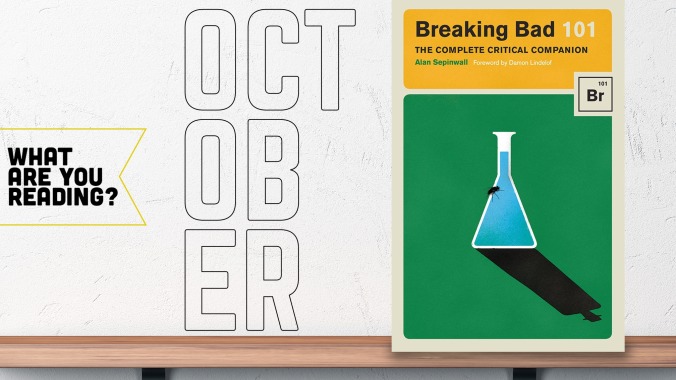Unlike the rest of America, I have only recently begun the thrill ride that is the five seasons of AMC’s Breaking Bad. I remember the many Sunday nights on Twitter when there was a sudden torrent of “Holy shit!!!” tweets, prompted by some plot twist/death/explosion from the show. Thanks to Netflix, I’m now able to relive the series at my own pace. And supplementing the show recaps from The A.V. Club is a new hardbound compendium of reviews from Uproxx television critic Alan Sepinwall, Breaking Bad 101: The Complete Critical Companion. Authoritative and satisfyingly tactile, Breaking Bad 101 has found a home next to my TV remote, a book I turn to after each episode to provide context and insight that I probably missed on first viewing.
Laura Adamczyk
There’s never a bad time to read Leslie Jamison. With extraordinary intelligence and compassion, her bestselling 2014 essay collection, The Empathy Exams, explores how we—to use a phrase from another esteemed essayist—regard the pain of others. She relates her time as a medical actor; profiles runners undergoing the infamous Barkley Marathons; and considers Morgellons disease, a condition in which the afflicted believe their skin is infected by bugs or objects. These past few weeks, in which women’s trauma has come to the fore through yet another round of abuse allegations against a powerful, wealthy man, made me want to reread the collection’s final essay in particular.
In “Grand Unified Theory Of Female Pain,” Jamison doesn’t focus on sexual abuse, specifically, but how women have expressed, or been allowed to express, their pain, as a response to abuse or other “wounds,” large and small. She identifies a “post-wounded” duality that many women occupy, at once declaring and distancing themselves from their pain, for fear of dramatizing it: “Post-wounded women make jokes about being wounded or get impatient with women who hurt too much… More than anything they refuse to care about it, refuse to hurt about it—or else they are endlessly self-aware about the posture they have adopted if they allow themselves this hurting.” Like so many great essayists, Jamison is able to present multiple, seemingly contrasting ideas at once, never taking a side for its own sake and constantly interrogating her own argument.
Jamison similarly casts a wide net of representations to deepen and expand her thoughts—from Kate Bush and HBO’s Girls to Anne Carson and her own personal experiences. (There is an especially cathartic run deconstructing the 1976 film Carrie.) The entire collection builds to this, its most potent essay, and she develops powerful momentum within it. “The wounded woman gets called a stereotype and sometimes she is,” she writes near the end. “But sometimes she’s just true. I think the possibility of fetishizing pain is no reason to stop representing it. Pain that gets performed is still pain.” Jamison makes such bold, and boldly empathic, declarations that this essay reads like a manifesto—one for today and every day.
Alex McLevy
It’s October, which means I am contractually obligated to seek out a potentially trashy thriller or horror novel and consume it slowly, over the course of several weeks, savoring the scares like a fine wine (even if it ends up being more like the literary equivalent of a bottle of Yellow Tail). This year, the candidate was Stephanie Perkins’ There’s Someone Inside Your House, a slasher/romance mashup that does the latter more successfully than the former. Categorized as YA—presumably for the sole reason that it’s about high-school students—it actually mimics the beats of an average slasher relatively faithfully, in the sense that most of the victims are people who we don’t know and/or don’t care about. Interwoven between the slayings is a standard-issue romance between Makani, a bi-racial girl recently transplanted from Hawaii to small-town Midwest, the brooding boy she falls for, and the secret she’s hiding from her newfound friends. It’s well-constructed and lighter than air, a cross between an after-school special and a ’80s slasher, albeit with even less motivation for the killer than normal. Would I recommend it? If you’ve got a few hours to kill and a fondness for silliness, this would fit the bill nicely.
But it ended up being a palate cleanser for Arundhati Roy’s The Ministry Of Utmost Happiness. The book is receiving its share of criticism, and some of it’s deserved: It’s a sprawling, messy affair, too unfocused to achieve the laser-like perfection of Roy’s The God Of Small Things. Still, her prose is often stop-you-in-your-tracks gorgeous, whether she’s describing a woman’s hands or the rapacious effects of corporate capitalism. It’s a rich and rewarding read that continually unveils deliciously good individual sentences (“The spotted owlet on the street ducked and bobbed with the delicacy and immaculate manners of a Japanese businessman”), and even if the overall plot ended up feeling like the lingering fog of a long-forgotten fable, it’s never far from providing another crystalline gem of metaphor or aphorism.











![HBO teases new Euphoria, Larry David, and much more in 2026 sizzle reel [Updated]](https://img.pastemagazine.com/wp-content/avuploads/2025/12/12100344/MixCollage-12-Dec-2025-09-56-AM-9137.jpg)






























